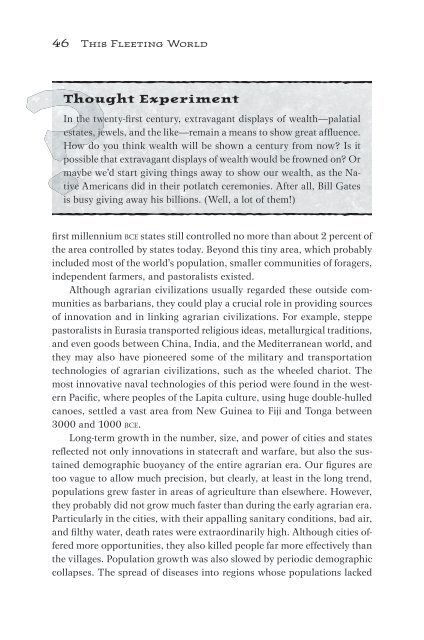This Fleeting World
This Fleeting World
This Fleeting World
You also want an ePaper? Increase the reach of your titles
YUMPU automatically turns print PDFs into web optimized ePapers that Google loves.
46 <strong>This</strong> <strong>Fleeting</strong> <strong>World</strong><br />
Thought Experiment<br />
In the twenty-first century, extravagant displays of wealth—palatial<br />
estates, jewels, and the like—remain a means to show great affluence.<br />
How do you think wealth will be shown a century from now? Is it<br />
possible that extravagant displays of wealth would be frowned on? Or<br />
maybe we’d start giving things away to show our wealth, as the Native<br />
Americans did in their potlatch ceremonies. After all, Bill Gates<br />
is busy giving away his billions. (Well, a lot of them!)<br />
first millennium bce states still controlled no more than about 2 percent of<br />
the area controlled by states today. Beyond this tiny area, which probably<br />
included most of the world’s population, smaller communities of foragers,<br />
independent farmers, and pastoralists existed.<br />
Although agrarian civilizations usually regarded these outside communities<br />
as barbarians, they could play a crucial role in providing sources<br />
of innovation and in linking agrarian civilizations. For example, steppe<br />
pastoralists in Eurasia transported religious ideas, metallurgical traditions,<br />
and even goods between China, India, and the Mediterranean world, and<br />
they may also have pioneered some of the military and transportation<br />
technologies of agrarian civilizations, such as the wheeled chariot. The<br />
most innovative naval technologies of this period were found in the western<br />
Pacific, where peoples of the Lapita culture, using huge double-hulled<br />
canoes, settled a vast area from New Guinea to Fiji and Tonga between<br />
3000 and 1000 bce.<br />
Long-term growth in the number, size, and power of cities and states<br />
reflected not only innovations in statecraft and warfare, but also the sustained<br />
demographic buoyancy of the entire agrarian era. Our figures are<br />
too vague to allow much precision, but clearly, at least in the long trend,<br />
populations grew faster in areas of agriculture than elsewhere. However,<br />
they probably did not grow much faster than during the early agrarian era.<br />
Particularly in the cities, with their appalling sanitary conditions, bad air,<br />
and filthy water, death rates were extraordinarily high. Although cities offered<br />
more opportunities, they also killed people far more effectively than<br />
the villages. Population growth was also slowed by periodic demographic<br />
collapses. The spread of diseases into regions whose populations lacked


